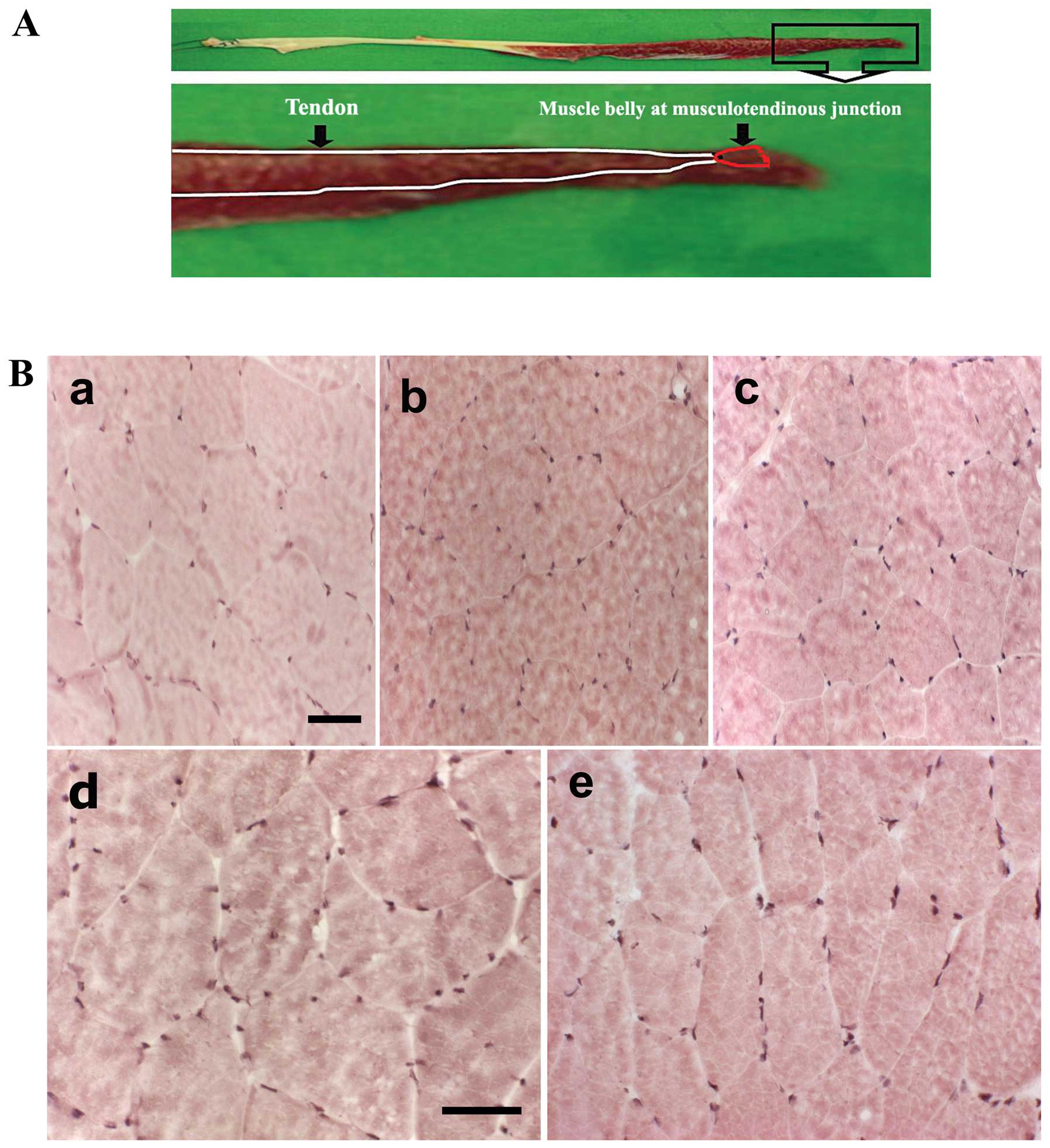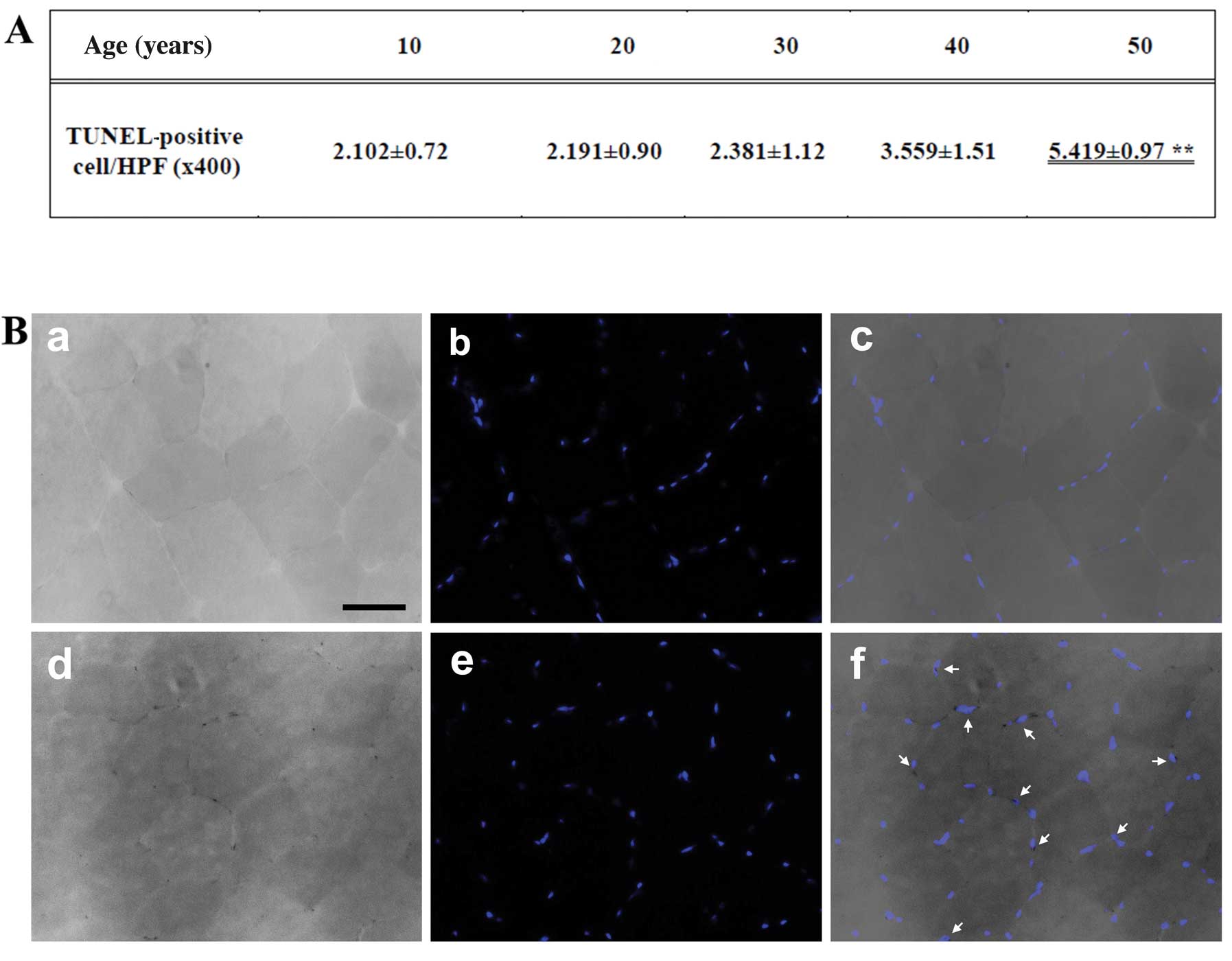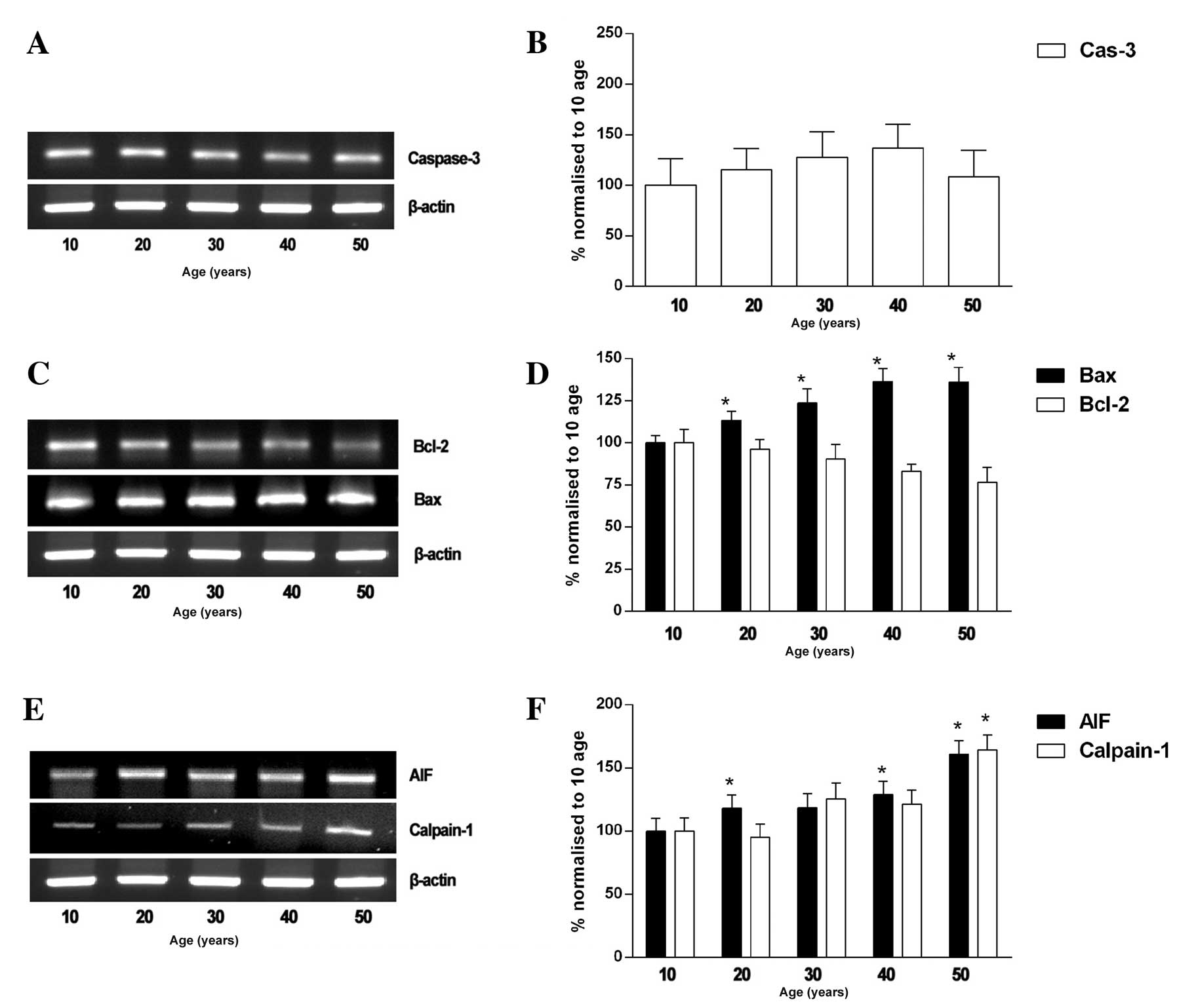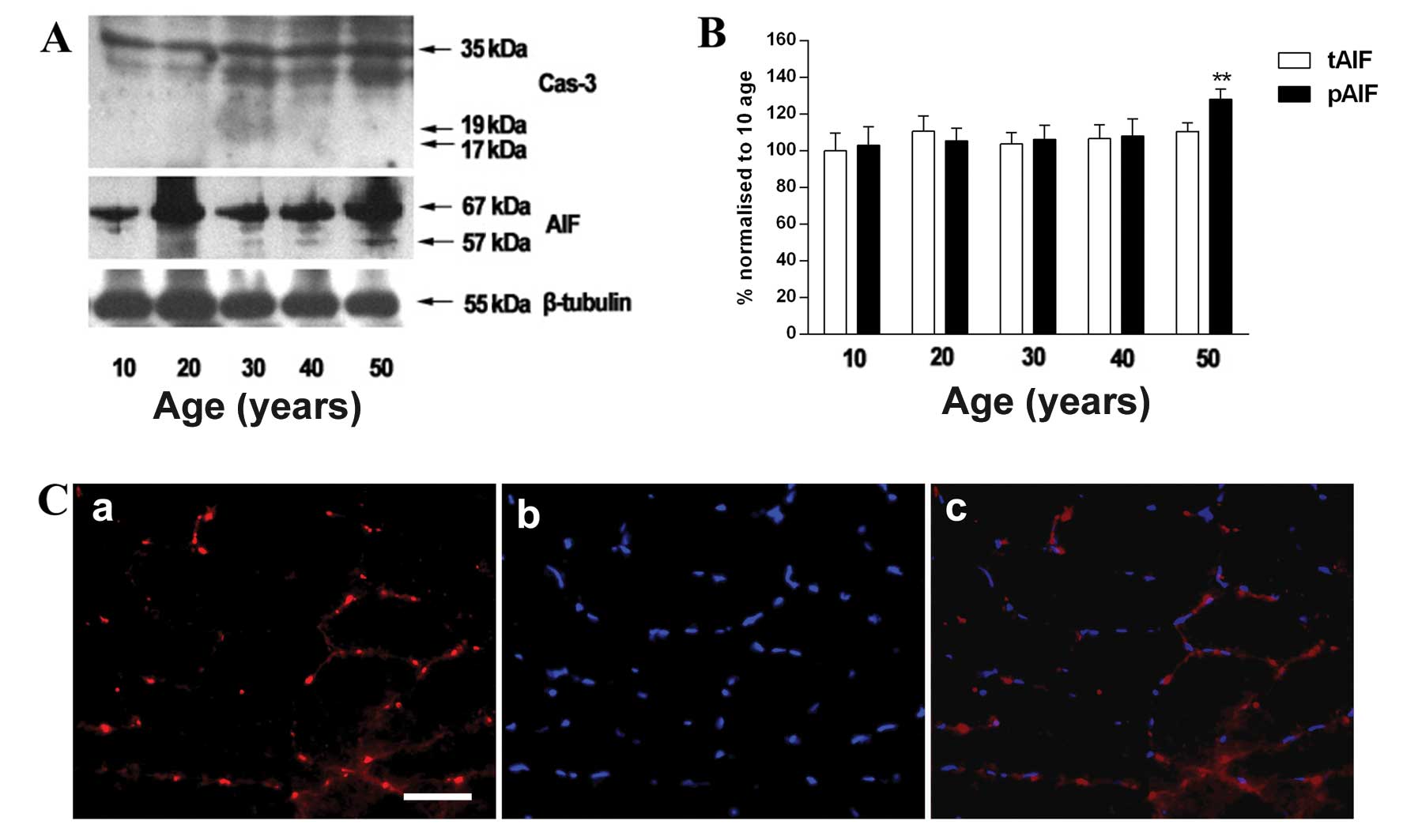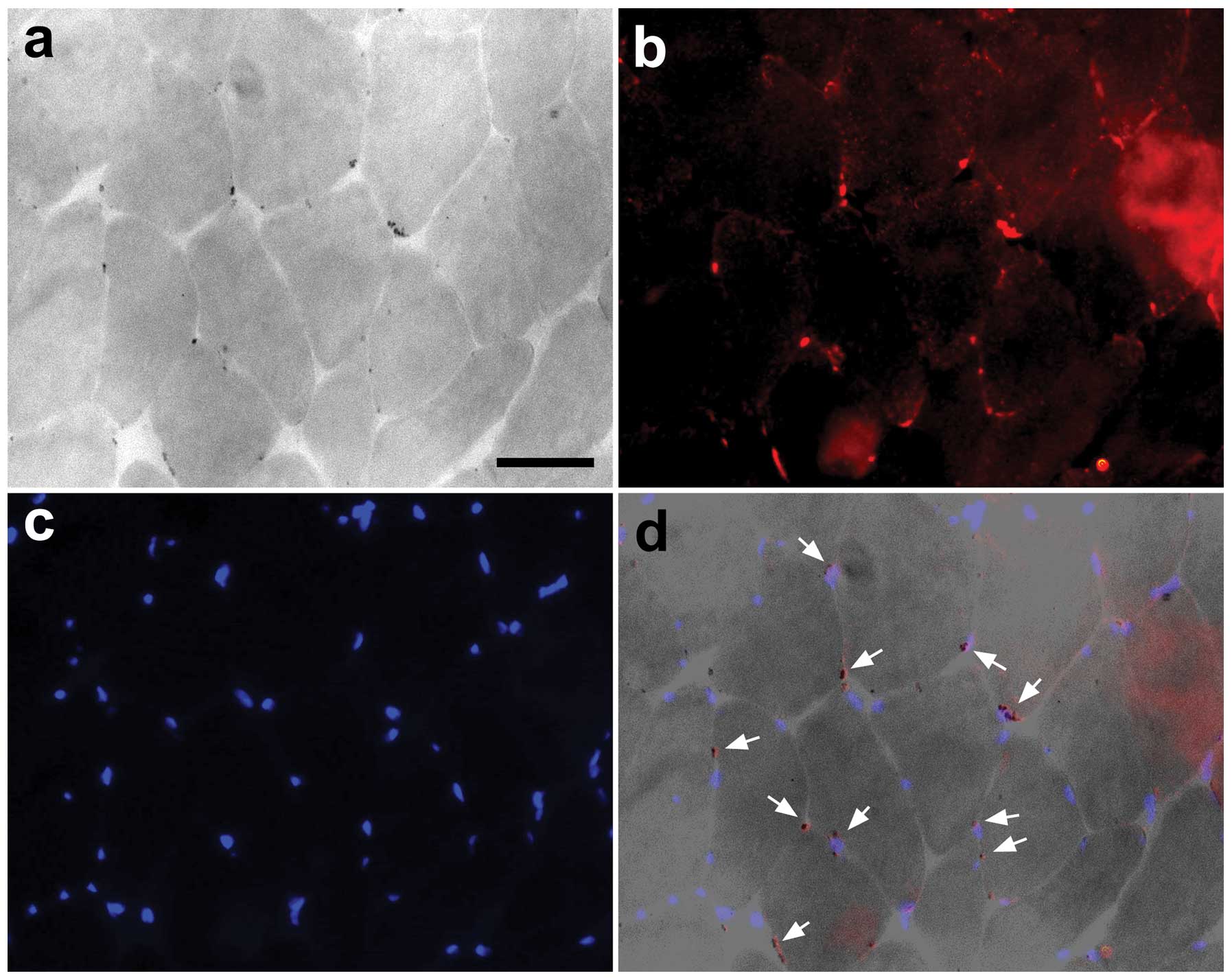|
1
|
Nikolić M, Bajek S, Bobinac D, Vranić TS
and Jerković R: Aging of human skeletal muscles. Coll Antropol.
29:67–70. 2005.
|
|
2
|
Marcell TJ: Sarcopenia: causes,
consequences, and preventions. J Gerontol A Biol Sci Med Sci.
58:M911–M916. 2003. View Article : Google Scholar : PubMed/NCBI
|
|
3
|
Roubenoff R: Sarcopenia and its
implications for the elderly. Eur J Clin Nutr. 54:S40–S47. 2000.
View Article : Google Scholar
|
|
4
|
Hughes VA, Frontera WR, Roubenoff R, Evans
WJ and Singh MA: Longitudinal changes in body composition in older
men and women: role of body weight change and physical activity. Am
J Clin Nutr. 76:473–481. 2002.PubMed/NCBI
|
|
5
|
Lexell J: Human aging, muscle mass, and
fiber type composition. J Gerontol A Biol Sci Med Sci. 50:11–16.
1995.
|
|
6
|
Dirks A and Leeuwenburgh C: Apoptosis in
skeletal muscle with aging. Am J Physiol Regul Integr Comp Physiol.
282:R519–R527. 2002.PubMed/NCBI
|
|
7
|
Zhang Y and Herman B: Ageing and
apoptosis. Mech Ageing Dev. 123:245–260. 2002. View Article : Google Scholar : PubMed/NCBI
|
|
8
|
Wyllie AH, Kerr JF and Currie AR: Cell
death: the significance of apoptosis. Int Rev Cytol. 68:251–306.
1980. View Article : Google Scholar
|
|
9
|
Mayer B and Oberbauer R: Mitochondrial
regulation of apoptosis. News Physiol Sci. 18:89–94. 2003.
|
|
10
|
Primeau AJ, Adhihetty PJ and Hood DA:
Apoptosis in heart and skeletal muscle. Can J Appl Physiol.
27:349–395. 2002. View
Article : Google Scholar : PubMed/NCBI
|
|
11
|
Cai J, Yang J and Jones DP: Mitochondrial
control of apoptosis: the role of cytochrome c. Biochim
Biophys Acta. 1366:139–149. 1998. View Article : Google Scholar : PubMed/NCBI
|
|
12
|
Green D and Kroemer G: The central
executioners of apoptosis: caspases or mitochondria? Trends Cell
Biol. 8:267–271. 1998. View Article : Google Scholar : PubMed/NCBI
|
|
13
|
Holloszy JO, Chen M, Cartee GD and Young
JC: Skeletal muscle atrophy in old rats: differential changes in
the three fiber types. Mech Ageing Dev. 60:199–213. 1991.
View Article : Google Scholar : PubMed/NCBI
|
|
14
|
Cory S and Adams JM: The Bcl2 family:
regulators of the cellular life-or-death switch. Nat Rev Cancer.
2:647–656. 2002. View
Article : Google Scholar : PubMed/NCBI
|
|
15
|
Danial NN and Korsmeyer SJ: Cell death:
critical control points. Cell. 116:205–219. 2004. View Article : Google Scholar : PubMed/NCBI
|
|
16
|
Tsujimoto Y: Cell death regulation by the
Bcl-2 protein family in the mitochondria. J Cell Physiol.
195:158–167. 2003. View Article : Google Scholar : PubMed/NCBI
|
|
17
|
Baker SJ and Reddy EP: Modulation of life
and death by the TNF receptor superfamily. Oncogene. 17:3261–3270.
1998. View Article : Google Scholar : PubMed/NCBI
|
|
18
|
Candé C, Cohen I, Daugas E, Ravagnan L,
Larochette N, Zamzami N and Kroemer G: Apoptosis-inducing factor
(AIF): a novel caspase-independent death effector released from
mitochondria. Biochimie. 84:215–222. 2002.PubMed/NCBI
|
|
19
|
Candé C, Vahsen N, Garrido C and Kroemer
G: Apoptosis-inducing factor (AIF): caspase-independent after all.
Cell Death Differ. 11:591–595. 2004.PubMed/NCBI
|
|
20
|
Li LY, Luo X and Wang X: Endonuclease G is
an apoptotic DNase when released from mitochondria. Nature.
412:95–99. 2001. View
Article : Google Scholar : PubMed/NCBI
|
|
21
|
van Loo G, Schotte P, van Gurp M, Demol H,
Hoorelbeke B, Gevaert K, Rodriguez I, Ruiz-Carrillo A,
Vandekerckhove J, Declercq W, Beyaert R and Vandenabeele P:
Endonuclease G: a mitochondrial protein released in apoptosis and
involved in caspase-independent DNA degradation. Cell Death Differ.
8:1136–1142. 2001.PubMed/NCBI
|
|
22
|
Adams V, Gielen S, Hambrecht R and Schuler
G: Apoptosis in skeletal muscle. Front Biosci. 6:D1–D11. 2001.
|
|
23
|
Pollack M and Leeuwenburgh C: Apoptosis
and aging: role of the mitochondria. J Gerontol A Biol Sci Med Sci.
56:B475–B482. 2001. View Article : Google Scholar : PubMed/NCBI
|
|
24
|
Joza N, Susin SA, Daugas E, Stanford WL,
Cho SK, Li CY, Sasaki T, Elia AJ, Cheng HY, Ravagnan L, Ferri KF,
Zamzami N, Wakeham A, Hakem R, Yoshida H, Kong YY, Mak TW,
Zúñiga-Pflücker JC, Kroemer G and Penninger JM: Essential role of
the mitochondrial apoptosis-inducing factor in programmed cell
death. Nature. 410:549–554. 2001. View
Article : Google Scholar : PubMed/NCBI
|
|
25
|
Daugas E, Nochy D, Ravagnan L, Loeffler M,
Susin SA, Zamzami N and Kroemer G: Apoptosis inducing dactor (AIF)
a ubiquitous mitochondrial oxidoreductase involved in apoptosis.
FEBS Lett. 476:118–123. 2000. View Article : Google Scholar : PubMed/NCBI
|
|
26
|
Daugas E, Susin SA, Zamzami N, Ferri KF,
Irinopoulou T, Larochette N, Prévost MC, Leber B, Andrews D,
Penninger J and Kroemer G: Mitochondrio-nuclear translocation of
AIF in apoptosis and necrosis. FASEB J. 14:729–739. 2000.PubMed/NCBI
|
|
27
|
Suzuki K, Imajoh S, Emori Y, Kawasaki H,
Minami Y and Ohno S: Calcium-activated neutral protease and its
endogenous inhibitor. Activation at the cell membrane and
biological function. FEBS Lett. 220:271–277. 1987. View Article : Google Scholar : PubMed/NCBI
|
|
28
|
Ueyama H, Kumamoto T, Fujimoto S, Murakami
T and Tsuda T: Expression of three calpain isoform genes in human
skeletal muscles. J NeurolSci. 155:163–169. 1998.PubMed/NCBI
|
|
29
|
Dargelos E, Poussard S, Brulé C, Daury L
and Cottin P: Calcium-dependent proteolytic system and muscle
dysfunctions: a possible role of calpains in sarcopenia. Biochimie.
90:359–368. 2008. View Article : Google Scholar : PubMed/NCBI
|
|
30
|
Dirks AJ and Leeuwenburgh C: Aging and
lifelong calorie restriction result in adaptations of skeletal
muscle apoptosis repressor, apoptosis-inducing factor, X-linked
inhibitor of apoptosis, caspase-3, and caspase-12. Free Radic Biol
Med. 36:27–39. 2004. View Article : Google Scholar
|
|
31
|
Norberg E, Gogvadze V, Ott M, Horn M,
Uhlén P, Orrenius S and Zhivotovsky B: An increase in intracellular
Ca2+is required for the activation of mitochondrial
calpain to release AIF during cell death. Cell Death Differ.
15:1857–1864. 2008.
|
|
32
|
Polster BM, Basañez G, Etxebarria A,
Hardwick JM and Nicholls DG: Calpain I induces cleavage and release
of apoptosis-inducing factor from isolated mitochondria. J Biol
Chem. 280:6447–6454. 2005. View Article : Google Scholar : PubMed/NCBI
|
|
33
|
Park SY, Kim HY, Lee JH, Yoon KH, Chang MS
and Park SK: Age-dependent induction of apoptosis-inducing factor
(AIF) in the human semitendinosus skeletal muscle. Cell Mol Biol
Lett. 15:1–12. 2010. View Article : Google Scholar : PubMed/NCBI
|
|
34
|
Saiki RK, Bugawan TL, Horn GT, Mullis KB
and Erlich HA: Analysis of enzymatically amplified beta-globin and
HLA-DQ alpha DNA with allele-specific digonucleotide probes.
Nature. 324:163–166. 1986. View
Article : Google Scholar : PubMed/NCBI
|
|
35
|
Borisov AB and Carlson BM: Cell death in
denervated skeletal muscle is distinct from classical apoptosis.
Anat Rec. 258:305–318. 2000. View Article : Google Scholar : PubMed/NCBI
|
|
36
|
Sandri M, Carraro U, Podhorska-Okolov M,
Rizzi C, Arslan P, Monti D and Franceschi C: Apoptosis, DNA damage
and ubiquitin expression in normal and mdx muscle fibers
after exercise. FEBS Lett. 373:291–295. 1995. View Article : Google Scholar : PubMed/NCBI
|
|
37
|
Strasser H, Tiefenthaler M, Steinlechner
M, Eder I, Bartsch G and Konwalinka G: Age-dependent apoptosis and
loss of rhabdosphincter cells. J Urol. 164:1781–1785. 2000.
View Article : Google Scholar : PubMed/NCBI
|
|
38
|
Alway SE, Degens H, Krishnamurthy G and
Smith CA: Potential role for Id myogenic repressors in apoptosis
and attenuation of hypertrophy in muscles of aged rats. Am J
Physiol Cell Physiol. 283:C66–C76. 2002. View Article : Google Scholar : PubMed/NCBI
|
|
39
|
Susin SA, Lorenzo HK, Zamzami N, Marzo I,
Snow BE, Brothers GM, Mangion J, Jacotot E, Costantini P, Loeffler
M, Larochette N, Goodlett DR, Aebersold R, Siderovski DP, Penninger
JM and Kroemer G: Molecular characterization of mitochondrial
apoptosis-inducing factor. Nature. 397:441–446. 1999. View Article : Google Scholar : PubMed/NCBI
|
|
40
|
Bidère N, Lorenzo HK, Carmona S, Laforge
M, Harper F, Dumont C and Senik A: Cathepsin D triggers Bax
activation, resulting in selective apoptosis-inducing factor (AIF)
relocation in T lymphocytes entering the early commitment phase to
apoptosis. J Biol Chem. 278:31401–31411. 2003.PubMed/NCBI
|
|
41
|
Susin SA, Zamzami N, Castedo M, Hursch T,
Marchetti P, Macho A, Daugas E, Geuskens M and Kroemer G: Bcl-2
inhibits the mitochondrial release of an apoptogenic protease. J
Exp Med. 184:1331–1341. 1996. View Article : Google Scholar : PubMed/NCBI
|
|
42
|
Kluck RM, Bossy-Wetzel E, Green DR and
Newmeyer DD: The release of cytochrome c from mitochondria:
a primary site for Bcl-2 regulation of apoptosis. Science.
275:1132–1136. 1997.
|
|
43
|
Song W, Kwak HB and Lawler JM: Exercise
training attenuates age-induced changes in apoptotic signaling in
rat skeletal muscle. Antioxid Redox Signal. 8:517–528. 2006.
View Article : Google Scholar : PubMed/NCBI
|
|
44
|
Chen M, Won DJ, Krajewski S and Gottlieb
RA: Calpain and mitochondria in ischemia/reperfusion injury. J Biol
Chem. 277:29181–29186. 2002. View Article : Google Scholar : PubMed/NCBI
|



